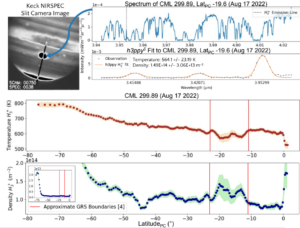My current research is looking at infrared spectra taken in the region of Jupiter’s Great Red Spot (GRS) using instruments from the IRTF and Keck observatories (iSHELL & NIRSPEC) (and maybe JWST in the future!). I use h3ppy, a Python package which models and fits H₃⁺ lines, to compare bright emission lines in the same wavelength ranges as our data. H₃⁺ is an especially nice molecule to observe thanks to its prevalence in the upper atmospheres of the giant planets, its tendency to emit in regions of methane absorption, and its unusual temporal sensitivity to changes in local temperature and density.
h3ppy derives temperatures and densities from the magnitude ratios of H₃⁺ emission line peaks, and with it, I can map these temperatures (and less accurately, densities,) on and around the GRS. This will help determine how the environment in Jupiter’s upper atmosphere varies in local time over spans of minutes, hours, weeks, and years!

Example of the results of calculating temperatures from a single spectrum. Each pixel in the slit (the black line cutting through the planet in the upper left) has a corresponding spectrum (upper right), and thus its temperature and density can be derived using an H₃⁺ model. These pixels map to specific longitudes and latitudes on Jupiter.
 From early maps I can see interesting structure in both temperature and density. They are still preliminary, so there is plenty more data to be reduced and added to the map as well as improvements to be made to my data reduction pipeline!
From early maps I can see interesting structure in both temperature and density. They are still preliminary, so there is plenty more data to be reduced and added to the map as well as improvements to be made to my data reduction pipeline!
There is more context available for these figures on my 2023 EPSC-DPS Poster!